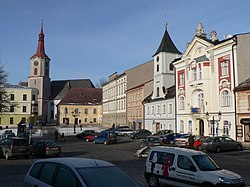Králíky
Králíky | |
|---|---|
Town | |
 Town square | |
 Flag  Coat of arms | |
 Králíky Location in the Czech Republic | |
| Coordinates: 50°5′2″N 16°45′38″E / 50.08389°N 16.76056°ECoordinates: 50°5′2″N 16°45′38″E / 50.08389°N 16.76056°E | |
| Country | |
| Region | Pardubice |
| District | Ústí nad Orlicí |
| First mentioned | 1367 |
| Government | |
| • Mayor | Václav Kubín |
| Area | |
| • Total | 52.78 km2 (20.38 sq mi) |
| Elevation | 550 m (1,800 ft) |
| Population (2020-01-01[1]) | |
| • Total | 4,205 |
| • Density | 80/km2 (210/sq mi) |
| Time zone | UTC+1 (CET) |
| • Summer (DST) | UTC+2 (CEST) |
| Postal code | 561 69 |
| Website | www |
Králíky (Czech pronunciation: [ˈkraːliːkɪ]; German: Grulich) is a town in the Ústí nad Orlicí District in the Pardubice Region of the Czech Republic. It has around 4,200 inhabitants. The centre of the town is historically significant and is protected by law as Urban monument zone.
Administrative parts[]
Villages of Červený Potok, Dolní Boříkovice, Dolní Hedeč, Dolní Lipka, Heřmanice, Horní Boříkovice, Horní Hedeč, Horní Lipka, Kopeček and Prostřední Lipka are administrative parts of Králíky.
History[]
The oldest recorded mention of Grulich dates back to 1367. It is a record preserved in the country's tables of law, by which Charles IV, presented the castle of Žampach and "The mountain of Grulich" (Montana in Greylichs) belonging to it to Čeněk of Potštejn. However, this record concerns only some unspecified mines. The proper town came into being as late as the 16th century and the first record dates to 1568. In 1577 the town and ten neighbouring villages were bought by Zdeněk of Waldstein (his great-nephew was a famous commander in the 30 years´ war Albrecht von Wallenstein). Zdeněk of Waldstein chose the town of Grulich as the residence of his new manor and began to develop it. Except the manor house, vicarage and Protestant oratory (today's church of St. Michael Archangel), he had the square built into today's shape and on his request Rudolf II, Holy Roman Emperor, granted the town a privilege to hold three annual fairs. In the surroundings iron ore was probably mined and perhaps silver, and at that time the town was supposed to get two crossed mining hammers with a sword into its heraldry. There was an attempt to revive mining in the 17th century but it is believed to have been unsuccessful. The industry has never been restarted.
Near the curative springs above the town, Bishop , a native of Grulich, had in the years of 1696–1710 a monumental pilgrimage complex () built. A lot of visitors came to this pilgrimage place and poor inhabitants of the Grulich region made a living from these pilgrimages. Production and sale of souvenirs boomed. Woodcarving began to develop, and Christmas cribs and wooden characters that have found their way all over the world are reminders of this. The Christmas cribs were even sold in America as "the genuine Wiener cribs". Organ building and weaving also developed. Many cathedrals and churches all over Bohemia feature organs from the organ masters of Grulich, one of the greatest being in Prague's Loreta.
Weaving played an important role in the originating of a textile tradition, and Grulich canvas was successfully sold all over the country. One of the most important markets became Brno and from there the canvas found its way also to markets in Vienna.
In the 18th century the town suffered from fires, plague and wars. Though no major battles took place in the region the town suffered from the crossings of armies. Fights, plunderings and bribery took place here, as well as in other parts of the country. During the biggest fires in the years 1708 and 1767 a major part of the town burned down, including the most important buildings. The original wooden houses were replaced by stone ones. After Glatz in Silesia was surrendered to Prussia many of its inhabitants moved to Grulich and the town began to grow. Until 1918, the town of Grulich was part of the Austrian monarchy (Austria side after the compromise of 1867), in the Senftenberg in Böhmen – Žamberk District, one of the 94 Bezirkshauptmannschaften in Bohemia.[2]
In 1791 Grulich became the residence of a regulated magistrate. During a land re-organisation in 1850 the district law court, tax office and land office were established in Grulich. The district law court had worked with several short breaks for almost 100 years.
In 1938, it was occupied by the German Army as one of the municipalities in Sudetenland. The German speaking population was expelled in 1945 (see the Beneš decrees) and replaced by Czech settlers.
Notable people[]
- (1649–1710), bishop of Hradec Králové
- Wilhelm Öhl (1860–1936), writer
- Guido Franz Rotter (1860–1940), founded the first German youth hostel in 1884
- Hans Neuburg (1904–1983), graphic designer
Twin towns – sister cities[]
 Międzylesie, Poland
Międzylesie, Poland Solbiate Olona, Italy
Solbiate Olona, Italy Villmar, Germany
Villmar, Germany
References[]
- ^ "Population of Municipalities – 1 January 2020". Czech Statistical Office. 2020-04-30.
- ^ Die postalischen Abstempelungen auf den österreichischen Postwertzeichen-Ausgaben 1867, 1883 und 1890, Wilhelm Klein, 1967
- ^ "Home Page: Partnerská města". kraliky.eu (in Czech). Město Králíky. Retrieved 2020-08-26.
External links[]
 Media related to Králíky at Wikimedia Commons
Media related to Králíky at Wikimedia Commons- Official website
- Cities and towns in the Czech Republic
- Populated places in Ústí nad Orlicí District
